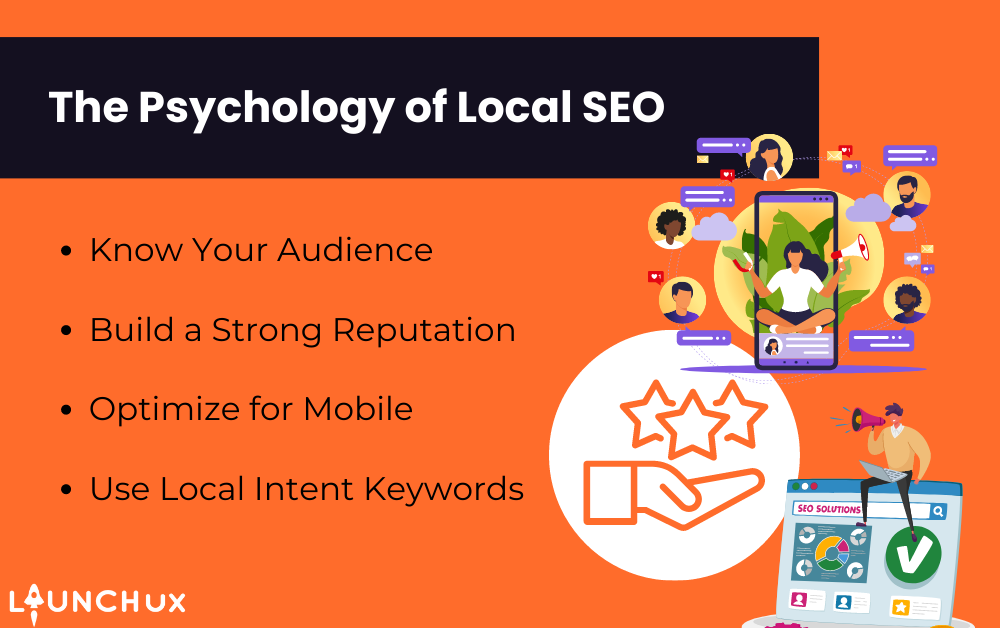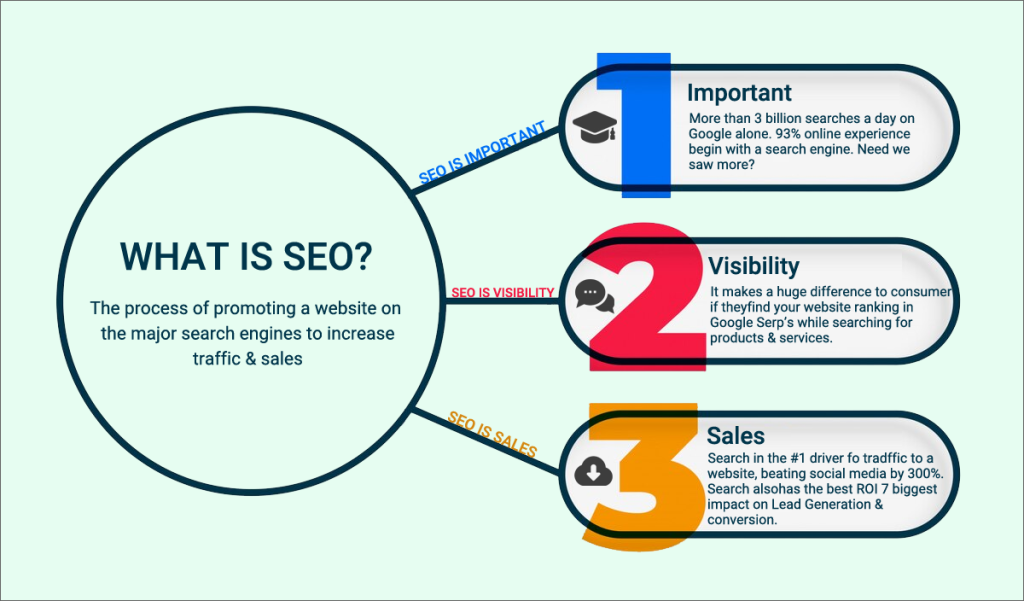Discover the intricate connection between user behavior and SEO strategies in this revealing exploration of the psychology behind search rankings.

Image courtesy of via DALL-E 3
Table of Contents
Welcome to the fascinating world of SEO, where psychology and technology come together to create an online experience like no other! SEO, which stands for Search Engine Optimization, is all about making websites more visible when people search for information on the internet. But what does psychology have to do with it? Well, understanding how users think and behave online is crucial for businesses looking to attract people to their websites. Let’s explore how businesses use SEO to connect with users in the digital realm.
What is SEO?
SEO is like a magic spell that helps websites appear more often when you search for something on the internet. Imagine you’re searching for the best pizza in town. With SEO, pizzerias that have used the right ingredients (keywords and content) will show up at the top of the search results, making it easier for you to find them. It’s like a treasure hunt where the best websites get the most gold coins (visitors)!
Why Does Psychology Matter for SEO?
Imagine walking into a store that has everything you love – your favorite toys, games, and snacks. That’s what businesses want their websites to feel like for users. By understanding what you like, how you think, and what makes you happy, they can create websites that attract and keep your attention. Psychology helps businesses know what users want and how to make their online experience enjoyable. It’s like having a superpower to read minds and give people exactly what they’re looking for!
Understanding User Intent
When you search for something online, have you ever thought about why you are looking for it? That’s what user intent is all about – understanding why people are searching for things. Let’s dive into this interesting topic!
Types of User Intent
There are three main types of user intent: informational, navigational, and transactional. Informational intent is when you want to learn something, like searching for “How to bake a cake.” Navigational intent is when you’re looking for a specific website, such as typing in the name of your favorite online game. Transactional intent is when you want to buy something, like searching for “Best headphones to buy.”
How to Identify User Intent
One way to figure out user intent is by analyzing the search queries people use. By looking at what words people type into search engines, we can better understand what they are looking for. Another way is to notice patterns in what people click on after searching. This helps businesses create websites that match what users are thinking about.
Keywords and User Thought Patterns
When you search for something online, you type in specific words or phrases, right? Well, those words are called keywords, and they are super important for businesses trying to get their websites to show up when you search. Imagine keywords like secret codes that help match your search with the right websites.
Long-Tail Keywords
Now, let’s talk about long-tail keywords. These are like longer, more detailed secret codes that match even more closely with what you’re looking for. For example, if you type in “best chocolate cake recipe,” that’s a long-tail keyword that helps find websites with exactly what you want, instead of just “chocolate cake,” which is more general.
The Role of Content in User Engagement
When you visit a website, what keeps you reading and exploring? It’s the content! Content plays a significant role in keeping users interested and engaged. Let’s dive into how good content can make all the difference in your online experience.

Image courtesy of launchux.com via Google Images
Creating Engaging Content
One of the keys to attracting and keeping users on a website is by creating engaging content. This means writing in a way that is interesting, informative, and easy to understand. When you write about topics that users care about and present the information in a clear and organized manner, you are more likely to hold their attention.
Visuals and Multimedia
While written content is essential, visuals and multimedia elements also play a crucial role in engaging users. Images, videos, and other media can help break up text, make the content more visually appealing, and provide additional information in a more engaging format. Including eye-catching visuals can enhance the overall user experience and keep visitors on your site longer.
User Experience (UX) and Site Design
In the vast world of the internet, it’s not just about what you say, but also how you say it. When it comes to websites, user experience (UX) and site design play a crucial role in how people interact with the online content. Let’s explore how the design and structure of a website can greatly impact user interaction.
Easy Navigation
Imagine going to a library with books scattered all over the place and no clear signs to guide you. It would be frustrating, right? Well, the same goes for websites. Easy navigation is like creating a clear roadmap for visitors to easily find what they’re looking for. Think of menus that are logically organized and layouts that are intuitive to use.
Mobile Friendliness
These days, almost everyone has a smartphone glued to their hand. So, it’s no surprise that websites need to be mobile-friendly. When a website is responsive and works well on mobile devices, it ensures that users can access the content comfortably wherever they are. Whether it’s checking the latest news or finding a yummy recipe, people rely on their phones for quick searches.
Trust and Credibility
When you visit a website, you want to make sure that the information you find there is trustworthy. But how can you tell if a website is reliable? One way is by looking at the content it provides. If a website uses accurate and up-to-date information, it’s more likely to be trustworthy. Make sure to check if the website uses secure links, because that shows they care about your safety online.

Image courtesy of www.pagetraffic.com via Google Images
Trust Signals
Have you ever looked at reviews before trying a new game or buying a toy? Reviews and testimonials are signals that can help you determine if a website is trustworthy. When you see that other people have had positive experiences with a website, you can feel more confident using it. Additionally, certifications from trusted organizations can also assure you that a website is reliable.
Behavioral Signals and Analytics
In the world of websites and online searching, understanding how people behave when they visit a site is like having a superpower. It helps businesses know what their users like, what they don’t, and what changes can be made to keep them interested. This superpower is known as Behavioral Signals and Analytics.
What Are Behavioral Signals?
Behavioral signals are like little clues that tell us how users are interacting with a website. It could be how long they stay on a page, which links they click on, or even how quickly they leave. By paying attention to these signals, businesses can learn a lot about what users find interesting and engaging.
Using Analytics Tools
To understand behavioral signals better, businesses use tools like Google Analytics. These tools gather data about user behavior on a website, such as how many people visit, where they come from, and what they do while they’re there. By looking at this data, businesses can make informed decisions on how to improve their site for better user experience and SEO.
Implementing Changes Based on Psychology
Once you understand how users think and behave online, you can use this knowledge to make improvements to your website and enhance your SEO strategies. By implementing changes based on psychology, you can create a more user-friendly experience that attracts and engages your target audience.
Doing an SEO Audit
An SEO audit is like giving your website a check-up to see how well it’s meeting the needs of your users. By conducting an audit, you can identify areas for improvement and make changes to optimize your site for better search engine rankings. This process involves looking at your website’s content, structure, and performance to ensure it aligns with what users are looking for.
Making Data-Driven Decisions
Using data and research is crucial in making informed decisions about your website. By analyzing user behavior and feedback, you can determine what’s working well and what needs improvement. This data-driven approach helps you make strategic changes that align with user preferences and behaviors, ultimately leading to better SEO performance.
Conclusion
In conclusion, understanding user psychology is a crucial aspect of effective Search Engine Optimization (SEO). By delving into how users think and behave online, businesses can tailor their websites to attract and engage their target audience more effectively.

Image courtesy of www.wix.com via Google Images
Key Takeaways
Throughout this article, we’ve explored various elements of SEO and user psychology. Here are the key points to remember:
- SEO stands for Search Engine Optimization and helps websites appear more frequently in online searches.
- Knowing user intent, search behaviors, and thought patterns is essential for selecting the right keywords.
- Creating engaging and high-quality content is paramount for keeping users interested and satisfied.
- User Experience (UX), site design, trust, and credibility play vital roles in building a successful website.
- Utilizing behavioral signals and analytics can provide valuable insights into user behavior and inform SEO strategies.
The Future of SEO
As technology continues to evolve and user behavior adapts, the field of SEO is likely to undergo significant changes as well. With an increasingly nuanced understanding of user psychology, businesses will be able to tailor their SEO strategies more precisely to meet the evolving needs of their audience.
Want to turn these SEO insights into real results? Seorocket is an all-in-one AI SEO solution that uses the power of AI to analyze your competition and craft high-ranking content.
Seorocket offers a suite of powerful tools, including a Keyword Researcher to find the most profitable keywords, an AI Writer to generate unique and Google-friendly content, and an Automatic Publisher to schedule and publish your content directly to your website. Plus, you’ll get real-time performance tracking so you can see exactly what’s working and make adjustments as needed.
Stop just reading about SEO – take action with Seorocket and skyrocket your search rankings today. Sign up for a free trial and see the difference Seorocket can make for your website!
Frequently Asked Questions (FAQs)
What Is SEO?
In simple terms, SEO stands for Search Engine Optimization. It is a way to make websites show up more often when people search online. Just like when you want to find your favorite toy in a messy room, SEO helps search engines like Google find the best websites that match what people are looking for.
Why Is Psychology Important for SEO?
Understanding psychology is crucial for SEO because it helps businesses create websites that people like to visit. By knowing what users think and feel, businesses can make their websites more appealing and helpful. It’s like knowing your friend’s favorite game so you can play together and have fun!
How Can I Start Using These Ideas?
If you want to start using these ideas to improve your website, you can begin by thinking about what your friends or family enjoy when they visit your site. Make sure your content is interesting and useful, use images and videos to keep them engaged, and make sure your website is easy to navigate. By understanding what your users like, you can make your website even better!







